The ownership of properties along Dublin’s most famous shopping street, Grafton Street, has changed significantly in recent years, with many of the 119 buildings on the street being bought by wealthy Irish families, often for cash. Here, for the first time, we name who owns Grafton Street.
Number one: Owned by Trinity College Dublin, the building on the eastern side of Grafton Street is home to the Provost of the college. Built in 1759, it is the only “grand town house in Dublin, with the exception of the Mansion House, that is still in its original use,” according to the National Inventory of Architectural Heritage (NIAH).
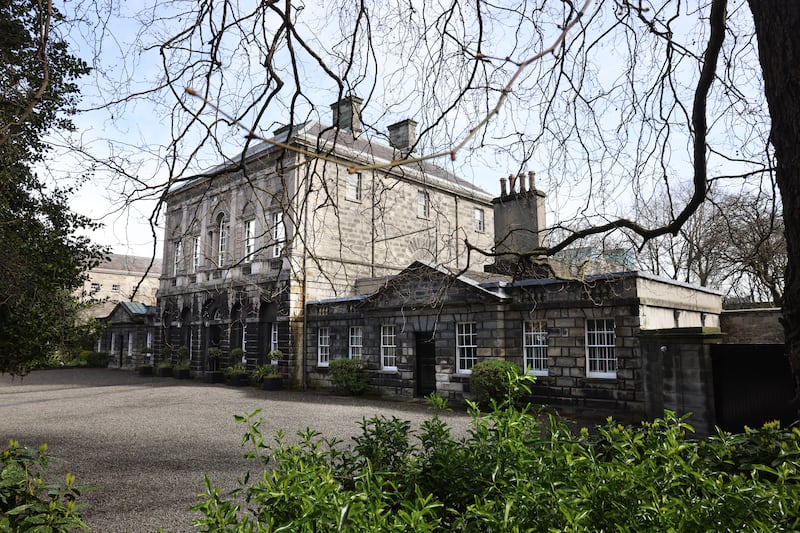
Number two: Occupied by coffee chain Starbucks and owned by Davy Irish Property Fund, an investment fund at the stockbroker. The building, on the corner with Nassau Street, was built around 1902 for an eyeglass retailer. It features in James Joyce’s Ulysses in which Leopold Bloom “crossed the Nassau Street corner and stood before the window of Yeates and Son”.
Number three: Currently being renovated, the building is owned by Glenberg Investments Unlimited Company, the property holding arm of Peter Mark, the hairdressing business established in 1961 by brothers Peter and Mark Keaveney. It was built around 1935.
Numbers four and five: Occupied by fast-food chain Abrakebabra (number 4) and jewellery shop Swarovski (number 5), the building was bought last year by Brian McKiernan, a former chief executive of stockbrokers Davy, and Emer McKiernan along with a number of partnerships, all with the same address in Howth. Brian McKiernan netted up to €70 million when Davy was bought by the Bank of Ireland in 2022. The buildings are currently leased for 10 years from November 2022 with an average rent of €260,000, according to the commercial lease register. Number 5 was built around 1890.
Number six: Occupied by newsagent Bus Stop, the building is owned by Signature Capital, a property investment company set up by former Investec executives Ciaran McNamara and Enda Woods in 2004. There is a five-year lease dated 2021 on the property with an average annual rent of €98,000. Number six is described in the NIAH as one of a “lively pair” of commercial buildings built in the early 20th century and designed by architect LA McDonnell, who designed a number of buildings on Grafton Street.
Number seven: Occupied by footwear shop Office, the building is owned by Irish Life. The NIAH describes it as a “typically eclectic commercial building”. It was built in 1896 for Carson Brothers booksellers.
Number eight: Occupied by health shop Health Matters, the three-storey commercial building is owned by Irish Life and was built around 1890.
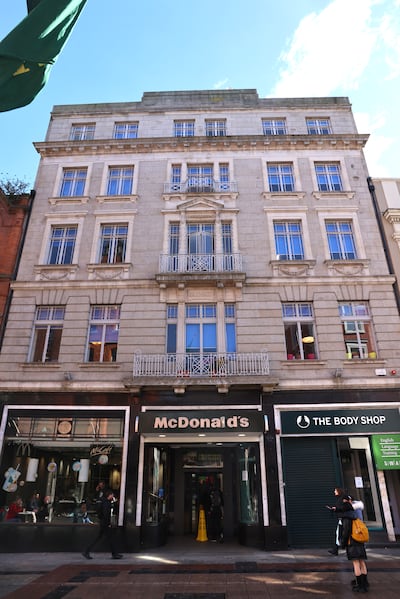
Numbers nine to 11: Home to a McDonald’s fast-food restaurant, the building is owned by the family behind Brennans Bread, who bought it in an off-market sale in 2021. A 20-year lease dated 2014 for the basement, ground, first and second floors carried an average annual rent of €600,000 and rates of €109,650 per year, according to the commercial lease register. The building, where the first McDonald’s outlet opened in 1977, is a former hotel, built in 1926 for the Mitchells, the family behind the wine outlets in Sandycove and the Custom House docks.
Number 12: Home to pharmacy Boots, the property is owned by the family behind the former Hayes, Conyngham & Robinson (HCR) pharmacy chain, which was sold to Boots in 1998, with the HCR shareholders retaining the property.
Built around 1730 and modified in the mid-1860s, it features a winged figure with a trumpet on the first floor exterior bearing the inscription “Praescripta Medecinae Accurate Composita”, meaning prescriptions of medicine are accurately compounded.
Numbers 13-14: Another shoe shop, Skechers, is located here. This is another Grafton Street building owned by the Brennans Bread family. It was bought in a €35 million off-market deal in 2016 from the German property group Deka Immobilien. There is a 10-year lease, dated June 2022, on the building, with an average annual rent of €850,000. The Brennan family companies used the two Grafton Street properties, 14 apartments on Upper Leeson Street, property at Charlemont Place and property on Dawson Street as security on a €100 million loan with AIB in 2023, company filings show. The buildings were part of the Grafton Street arcade that ran through to Duke Lane and where there were once 18 smaller shops.
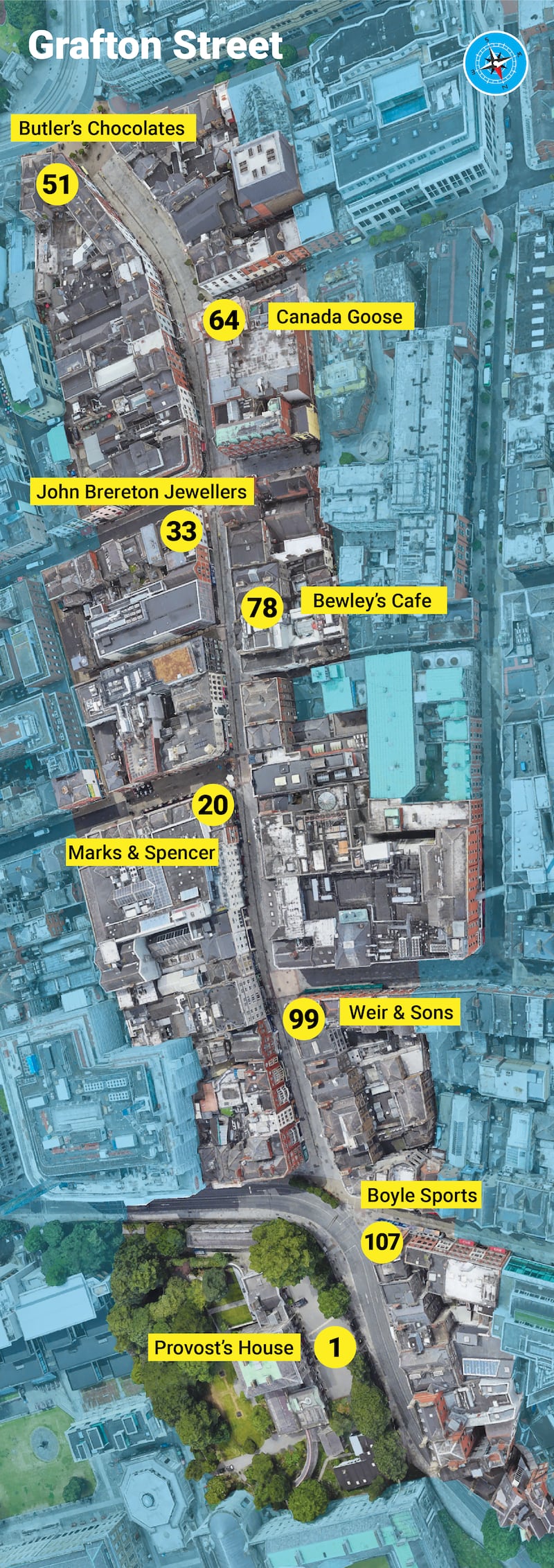
Numbers 15–20: Occupied by retailer Marks & Spencer, the property is owned by the UK retail chain, which bought it from Brown Thomas in 1994. Brown Thomas has its roots at number 16 Grafton Street, where a Hugh Brown opened a shop in 1848. The following year, with James Thomas, the business expanded into number 17. By the mid-1850s, it had also taken over number 15.
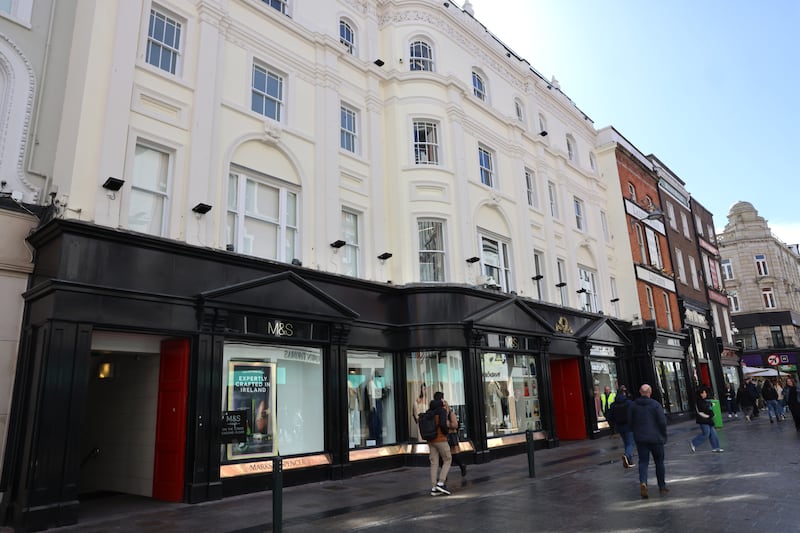
Numbers 21-23: Home to Hickey’s Pharmacy, jewellers Fields and Claire’s accessories, the building stands on the corner with Duke Street and was part of the Grafton Collection bought by the US Hines group in 2016 for a reported €55 million. A 15-year lease dated 2021 for the ground floor and basement has an average annual rent of €395,000. The Hines group, which has invested more than €3.6 billion in Irish property since 2011, is based in Houston, Texas. It was founded by the late Gerald Hines in Houston in 1957 and is still owned by the Hines family. The building was built for the Burton clothes retailer in the 1920s and the letter B can still be seen on the balconette.
Numbers 24-25: Occupied by retailer Eir and shoe shop Carl Scarpa, the building is owned by members of the family behind the Jameson whiskey brand. Described in the NIAH as a “large Victorian commercial building with a rich and characterful presence”, the building was constructed in 1862 and 1863.
Numbers 26-27: Occupied by the clothing shop & Other Stories, the building was bought by German property company Deka Immobilien in 2021 for a reported €22 million. The retailer & Other Stories is part of the H&M Group, which reportedly pays a rent of €925,000 per year. Deka sold numbers 13 to 14 to the Brennan family in 2016.
Numbers 28-29: Occupied by lingerie shop Victoria’s Secret, the building is owned by the founder of the Panda waste group, Eamon Waters (63), who bought this modern retail building on the corner with Lemon Street in 2023 for a reported €28 million. Waters sold his Beauparc utilities group for €1.4 billion three years ago. There is a lease of more than 15 years, dating from 2021, on the property with an average annual rent of €1.85 million.
Number 30: Home to shoe shop Ecco, the property is owned by Roscommon businessman Ray McConn (60) who operates the Budget and Avis car hire franchises through a company called Canvest Ltd. Canvest is ultimately owned by a holding company in the Isle of Man, Kioma Holdings. There is a six-year lease, dating 2022, for the basement and ground floor, with an average annual rent of €260,000. The three-storey gable-fronted commercial premises bears its date, 1911, on its front. It was built for the Scottish Temperance Life Assurance Company.
Number 31: Home to Card Gallery, the building is owned by Irish Life and yields €250,000 a year on average in rent. It was built as a house around 1821 and is representative of the “later phase” of the residential development of Grafton Street, according to the NIAH.
Number 32: Occupied by sunglasses shop Ray-Ban, the building is owned by Irish Life. The building was home to bookshop Hodges Figgis between 1797 and 1819, when it moved to number 104. There was an unsuccessful claim for compensation to the 1916 Property Losses (Ireland) Committee relating to the property from Louis Wine arising from the “destruction of [a] plate glass window” during the 1916 Rising.
Number 33: Home to John Brereton Jewellers, the property is owned by the Brereton family, who have been in the jewellery business in Dublin since 1916. The original Brereton outlet was on Capel Street and their Grafton Street shop was opened in 2012. West jewellers, said to have been one of the oldest jewellery shops in Europe, operated from number 33 until it closed in 2010. Built as a home in 1820, number 33 was substantially altered in 1859.
Numbers 34-35: Occupied by Castore, Gino’s Gelatos and Pandora jewellers, it is owned by insurance, savings and investment group Aviva. The corner building was built around 1950.
Number 36: Home to Dubray Bookshop, the building was bought by “Ken Healy and another” in July 2023, according to the Registry of Deeds. A commercial building dating from 1901, it was for many decades an outlet of the UK grocery and wine merchant chain Leverett & Frye. In the wake of the 1916 Rising the business made a claim to the Property Losses (Ireland) Committee for £3,112 9s and 11d for “looting and damage to stock, fixtures, fittings, windows and property”.
Number 37: Occupied by Carrolls Irish Gifts, the building is part-owned by the Odlum flour and milling family, who have been in business since the mid-1840s. WP & RO Holdings Property, the Oldlum company that part-owns number 37, was incorporated in 1935 and is ultimately owned by 65 shareholders, many with the surname Odlum, living in Ireland, England, Wales, Portugal, Malta, New Zealand and the USA. Historical mortgage documents show WP & RO has used property in London, Bristol, Glasgow and elsewhere in Britain as security against loans. Other shares in the building are owned by Signal Properties, which is owned by members of the Beatty family, while six individuals directly own shares of varying sizes in the building, which was constructed around 1840.
Number 38: Home to clothes shop Levis, the building is owned by Irish Life. It was built around 1905.
Number 39: Occupied by fast-food outlet Burger King, the building is owned by the O’Leary family, who own the Burger King franchise in the Republic. Their company, OKR, also has an interest in Apache Pizza. The founder of the group, Patrick “Pa” O’Leary, who died in 2002, opened his first restaurant in Killarney in the 1950s. OKR is owned by two companies in the British Virgin Islands, does not publish financial accounts and appears to own a considerable amount of property. It has 63 mostly satisfied mortgages registered, dating from 1969 to 2017, involving commercial property. In the early 20th century number 39, which was built around 1865, housed a showroom to advertise “the range of home comforts which could be achieved through electricity”, according to the ESB archives. Grafton Street was among the first streets in Dublin to get electric public lighting.
Number 40: JD King Trainers is located in this building, which is owned the Irish property business Iput plc.
Number 41: The Lego store is located in this Irish Life-owned building. There is an average annual rent of €500,000 on the building, which was constructed around 1840. Irish medical device business Fannin started out almost two centuries ago as a medical library and reading room at this address.
Number 42: Clothes shop Ted Baker trades out of the building, which is owned by New Ireland Assurance. The property was remodelled around 1870, according to the NIAH, with alterations for a shop, a “cigar divan” (a coffee shop that catered for smokers), billiard rooms and apartments.
Number 43: Another clothes shop, The North Face, is located in the building, which is owned by the Keaveneys, the family behind the Peter Mark hair salon who also own numbers 3 and 74 – the latter is a hair salon. A former town house, it was built around 1850 and re-fronted in 1912.
Number 44: Another footwear shop, Foot Locker, is located here; upstairs, Captain America’s restaurant has been on the first floor since 1971. The building is owned by the Davy Irish Property Fund. The fund also owns the rear of number 45. Number 44 was “possibly” built as a town house, around 1850, though it may be older than that and was refaced in that year, according to the NIAH.
Number 45: This property is currently on the market and is owned by businessman and property investor Chris Ledwidge (73). It was built, or refaced, around 1850.
Number 46: This building is home to mobile phone shop Three, while the Cigar Emporium is upstairs. The property is owned by Limerick billionaire JP McManus, through Plainemorte Investments, of Avonlea Demesne, Lucan, Co Dublin. Plainemorte, according to its 2022 accounts, owns two investment properties valued at €10.25 million. They generated rent of €797,000 in both 2021 and 2022. The company owes €8.6 million, by way of a promissory note with an interest rate of 8.6 per cent, and €2.1 million, by way of an interest-free loan, to a non-Irish company called Balmirex SA. Plainemorte banks with HSBC Private Bank, in Geneva, Switzerland, where McManus is tax resident. The building is a former town house built around 1820 as a pair with number 47.
Number 47: This building currently has no tenant. It is owned by Irish Life.
Number 48: Home to phone shop Vodafone, the building is owned by Irish Life. It was built as a former town house around 1820, as a pair with number 49.
Number 49: Retailer Circle K is located in this building, which is owned by Irish Life.
Number 50: Cosmetics shop Sculpted By Aimee operates out of this building, which is owned by Irish Life. The Commercial Lease Registers shows that there is a 10-year lease on the property, generating an average annual rent of €190,000. The four-storey former town house was built around 1845.
Number 51: Home to Celtic Jewellers and Butler’s Chocolates, with Grafton Barbers upstairs, the building is owned by Dublin man Michael Enoch (80), who owns a number of buildings on Grafton Street and elsewhere in Dublin. He runs a rent collection business, Prouds Rentals, from Proud’s Lane, off St Stephen’s Green, where his Guernsey company, Martina Investments Ltd, has an office. The four-storey commercial corner building, which also faces on to St Stephen’s Green, was built around 1860. It is the last building on the eastern side of the street at the Green.
Numbers 52-54: This is the second Bus Stop newsagents outlet on the street and is another property owned by Michael Enoch. The shop, facing St Stephen’s Green Shopping Centre on the corner with South King Street, is one of the smallest on Grafton Street. There are offices on the upper floors. The commercial lease register says a 20-year lease was agreed in 2017 for a shop on the ground floor and basement at an average annual rent of €150,000. Built in 1937, the corner turret is described by the NIAH as an “eye-catching addition to the skyline”.
Number 55: Occupied by Claddagh Jewellers, this building is probably the smallest on Grafton Street. The ground floor and basement, which are owned by Valerie Armstrong of Monkstown, Co Dublin, are on the market with a guide price of €2.5 million. The basement and ground floor have a 10-year lease with an average annual rent of €150,000. The first floor is owned by Michael Enoch.
Number 56: Home to the Camera Centre, the building is not much bigger than number 55 next door. It is owned by Camera Centre (Dublin) Ltd, which is in turn owned by Catherine, Stephanie, Owen, Lorna and Richard Howell and Amanda Green.
Numbers 57-58: Life Style Sports has an outlet in this Irish Life-owned building. It was bought in 2015 for €19.2 million. The property has a frontage on to South King Street around the corner. The property generates an average annual rent of €675,000. It was built around 1870 as a pair with number 59.
Number 59: Home to Benetton, the building is owned by Irish Life. During the War of Independence there was a cafe here called the Café Cairo frequented by members of British intelligence in Dublin, who were given the name the “Cairo Gang”.
Numbers 60-61: This is where the Disney Store is located. The property is owed by Aviva. The lane between 61 and 62 is called Tangier Lane and leads to the rear of the Gaiety Theatre and Neary’s pub.
Numbers 62-63: The building is owned by Dunnes Stores, the Irish supermarket chain which has owned the building since the mid-1990s but has not operated an outlet there for some years. The building was constructed in 1911. A sign on the second floor, “Waterproofers”, is a reminder of its original business, Waterproof House. Number 63, on the corner with Chatham Street, was built around 1840.
Number 64: Home to high-end clothes shop Canada Goose, the property is owned by three companies, Apperly Investments, Tailwind Investments and Martina Investments, with Apperly and Martina Investments being Guernsey companies with branches here. Martina Investments has an Irish branch at property owner Michael Enoch’s offices on Proud Lane, off St Stephen’s Green in Dublin. In 2022 Apperly switched its branch office address from Proud’s Lane to the offices of solicitor Paul Bohan in Bracetown Business Park, Dublin 15. Tailwind, with an address on Grattan Street, Dublin 2, is - according to the latest publicly available financial statements for the company - ultimately controlled by Anthony Lyons, an aviation entrepreneur who was convicted in 2012 of attacking and sexually assaulting a 27-year-old woman near his home on Griffith Avenue, Dublin. A 10-year lease for number 64 was negotiated in 2022 at an average annual rent of €500,000, according to the commercial property register. The property was built around 1890 and for many years was a branch of AIB.
Numbers 65-66: Clothes shop Massimo Dutti trades out of this building, which is owned by Iput plc (60 per cent) and Aviva Commercial Property Fund (40 per cent). At the time the sister brand of Spanish retail giant Zara moved into the address, rent dropped from €1.7 million to €865,000 a year.
Numbers 67-68: Occupied by another clothes retailer, Hugo Boss, the building is owned by a property trust by way of State Street, a US financial multinational that holds property on behalf of clients.
Number 69: The tenant is Dune footwear and the owner is Iput plc. A 20-year lease on the first, second, third and fourth floors, dating from 2015, generates an annual average rent of €54,000. Another lease on the ground floor and basement has an average annual rent of €337,500. It was built in 1906.
Number 70 (and 1/2 Harry Street): The tenant is Permanent TSB, with City Break studio apartments above, accessible via Harry Street. It is owned by property developer Johnny Ronan’s RGRE Grafton property group (one part of his wider property empire), to which a receiver was appointed by Bank of Ireland last November. The short-stay studio apartments rent for between €200-plus to €500-plus per night. The three-storey corner building was built in 1900 and designed by architect LA McDonnell for the American Shoe Company.
Number 71: Home to Boodles jewellers, the building is owned by the Leicester-based Charles Street Buildings Group, which traces its roots to a scrap metal business set up by Hughie and Paddy Murphy, who left south Armagh in the 1930s and settled in the English city. The property investment group, which is still family-owned, has more than six million square feet of property in Ireland and the UK, according to its website. The “high Victorian” building, on the corner of Grafton Street and Harry Street, was built in 1885 to 1889 for the Slyne & Co fashion business. “The health and comfort of the large staff of workers has been carefully looked after by the erection of spacious workrooms at the top of the house which are ventilated on the newest sanitary principles,” said a report at the time.
Number 72: The tenant is White Company, a homeware retailer. Owned by the Irish property business Iput plc, the building is rented out on a 15-year lease dating from 2018 with an average annual rent of €750,000. Number 72 was designed by Richard Orpen, brother of the painter William, to house a cinema, The Grafton Picture House. It opened on Easter Monday, April 11th, 1911. The Dubliners had one of their earliest performances in the venue in 1963. The cinema was converted into a shop in 1973.
Number 73: Home to Rocks jewellers, the building is owned by Irish Life, which receives an annual average rent of €205,000. TH Fielder, a women’s clothes shop and costumier “to the nobility and gentry of Great Britain and Ireland”, traded from this building in the late 1880s.
Number 74: The building’s owners, the Keaveney family, owners of Peter Mark, run a hair salon here. The first Peter Mark salon was opened by Peter and Mark Keaveney, then in their 20s, at number 87. The salon at number 74 opened soon after and has been the group’s flagship outlet ever since.
Number 75: Health food shop Holland & Barrett trades out of the building, which has been owned since 1998 by Dublin 4-based Declan and Michael Hayes. The former house was built around 1760.
Number 76: Footwear and bag shop Russell & Bromley trades out of this building, which is owned by Fitzmerrion Properties, a company associated with the Jameson Whiskey family. It generates an average annual rent of €300,000, according to the commercial lease register. Accounts for Fitzmerrion for 2022 show it valued the half of the property it then owned at €3 million and later bought the rest of the building from Fitzpatrick Footwear for an undisclosed price. Fitzpatrick Footwear is the company behind Fitzpatrick’s shoes, which closed its shop on Grafton Street in 2019 after 58 years of being in business. Fitzmerrion is controlled by Amache Ltd (of the British Virgin Islands) and its beneficial owner is Keith Jameson (64) of Ontario, Canada. Built as a town house around 1769, it was reconstructed in 1917 to house the offices of the Royal Irish Industries Association, established in 1886 to promote Irish craft.
Number 77: Another shoe shop, Thomas Patrick, is in this building, which is owned by members of the Fitzpatricks family, who have been involved in the footwear business in Ireland for almost a century. Thomas Patrick Shoes, the company behind the shop, paid rent of €132,000 in 2023 to the four owners of number 77, two of whom, Eilis and Orna Fitzpatrick, are the owners of the company, records show. The other two owners are not named. The building is a former town house, built around 1760.
Numbers 78-79 (and 2/4 Johnson’s Court): Home to perhaps Grafton Street’s most famous tenant, Bewley’s cafe, the property is owned by Johnny Ronan’s RGRE Grafton group, one part of his wider property empire, to which the Bank of Ireland appointed a receiver in November. The landlord has had a long and fractious relationship with the operator of the cafe, Patrick Campbell, who bought the Bewley’s brand in 1986. A lease, carrying an annual rent of €1.46 million, expired in August 2022, and agreement on a new rent may be necessary before the property can be valued and put on the market. The dispute between Ronan and the cafe included a recent court clash over whether or not the cafe’s famous Harry Clarke stained glass windows were part of the building. A judge ruled that four of them were and two of them were not. According to the NIAH, the 1926 building has an “extravagant facade, rising above the neighbouring properties, [and] is a rare example of the Egyptian Revival style in Ireland ... a landmark building and a much-loved institution.”
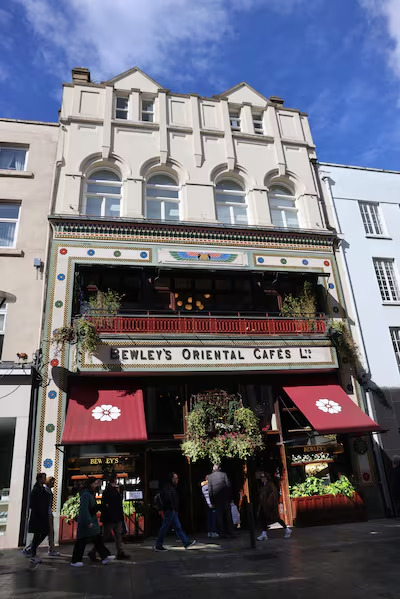
Number 80: Molton Brown perfumes trades out of this building, owned by Irish Life. A 14-year retail lease dated 2014 carried with it an average annual rent of €275,000. The four-storey building between Bewley’s and Johnsons Court was built around 1880.
Number 81: The tenant here is Rituals cosmetics. The building is owned by WP & RO Holdings Property Ltd, the Odlum family company that has an interest in number 37. Rebuilt in 1861 from a previous Georgian block, the building is one of a pair with number 82, with the top floor being an addition.
Number 82: Space NK cosmetics trades out of the building, which is owned by IBI Property Nominees, the Bank of Ireland investment arm. The building was rebuilt in 1860, along with number 81. The NIAH describes the facade as having an attractive example of decorative Victorian stuccowork.
Number 83: Another shoe shop, Dr Martens, trades out of this address. It was sold last year by Iput plc to Applay Central Ltd, a company ultimately owned by Claire, Susan, Alison and Laura O’Mara, all with addresses in Dublin. Claire O’Mara led the 2008 refurbishment of family-owned Hamilton House, a serviced offices business on Fitzwilliam Place, Dublin 2. Number 83 was built around 1860, most likely with residential accommodation on the upper floors, and rebuilt around 1914.
Number 84: Home to Lululemon clothing shop, the property is owned by New Ireland Assurance and generates an annual average rent of €400,000.
Numbers 85-86: Another shoe shop, Clarks, is located in this property, owned by Irish Life. There are offices above the shop. A 10-year lease on 125 metres of office space on the third floor dated February 2023 generates an average annual rent of €47,500. A five-year lease dated 2022 on the basement has an annual average rent of €35,000.
Number 87: Occupied by Pandora jewellers, the property is owned since February 2023 by Patrick and Karen Doran, of Shrewsbury Road, Dublin, and Mark Keating of Terenure, Dublin 6, through a company called Nutmeglane. Doran is a former owner of a packaging company called Americk, which he sold in 2016. Keating is chief financial officer of investment business Woodberry Capital, where Doran is chief executive. The building generates an annual average rent of €538,000.
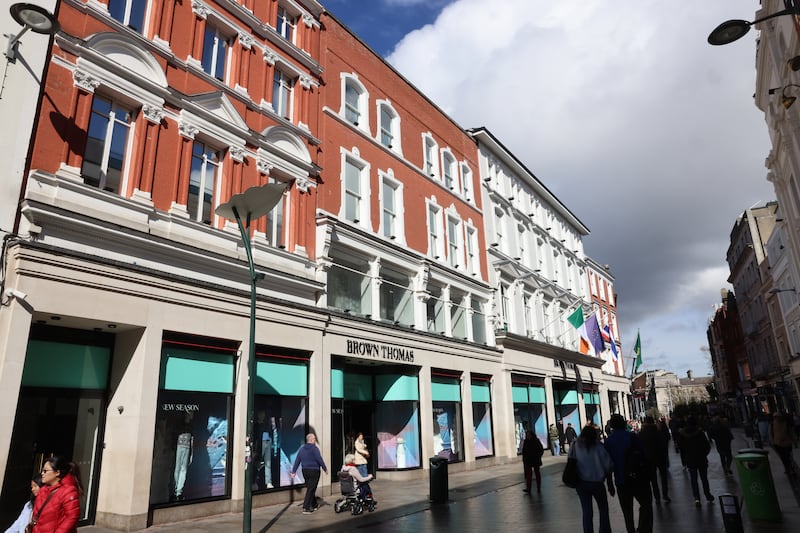
Numbers 88-95: Home to one of the street’s most prominent tenants, Brown Thomas, the building is owned by the Chirathivat family, a Thai family of Chinese descent that owns the Central Group, a major Thai retail business. The property was valued at €115 million in January 2023. The commercial register says a 20-year lease dated November 2022 carries an annual average rent of €14.9 million and rates of €916,292. The buildings making up the Brown Thomas department store were built at different times. Number 88 was built around 1910 and remodelled in 1995 when Brown Thomas moved into the former Switzer premises. Numbers 89 and 90 were built around 1865. Numbers 91 to 93 were built between 1859 and 1862, when they were designed for Switzer, Ferguson & Son – later Switzer & Co. Numbers 94 to 95, which end at the corner with Wicklow Street, were built in 1905. They were originally built to house the jeweller and silversmith, Edmund Johnson, maker of the Liam MacCarthy Cup (1922).
Numbers 96-99: Jewellers Weir & Sons occupy this prominent corner building. The property is owned by the business, which belongs to members of the Andrews family. Weir & Sons was founded in 1869 by Thomas Weir with the business name registered in 1916 and the company, Weir & Sons, registered in 1927. Maigread Weir married Arthur Andrews in 1943 and their son, David, great-grandson of the founder, ran the business until 2020. It is currently headed by his son, Christopher Andrews. Number 96, at the corner, which fronts on to Grafton Street and Wicklow Street, with a wraparound storefront, was built around 1881. Numbers 97 to 99 were built in the art deco style in the 1930s with the intention that the upper floors would be used as a Turkish baths, variously known as the Dublin Spa, the Russian-Turkish Baths or Maskora House. The business offered chiropody, colonic irrigation, solarium baths, and Swedish massages, with women catered for exclusively on Tuesdays and Thursday. The venture closed in 1937. Some of the display cases inside Weir’s date from the 1930s.
Numbers 100-101: The property is home to the street’s only remaining AIB branch and is owned by Irish Life. The commercial lease register shows the property, which fronts on to numbers four and five Wicklow Street, is the subject of a 20-year lease from 2010, with an annual average rent of €1.8 million. It was built in the early 1880s.
Numbers 102-103: Clothes retailer River Island trades from this building, which is owned by GLL BVK Street Dac, also the owner of number 104. GLL is owned by a German property investment fund. Accounts show the three buildings were valued at €33 million in 2022, when rental income (there was no tenant in 104) was €2.15 million. The five-storey over basement building dates from 1913 and was built “in a flamboyant Jacobean style” for West & Son jewellers, according to the NIAH.
Number 104: This property, owned by GLL, is vacant. Its Irish company’s accounts say the tenant ended the lease prematurely and paid a surrender premium in 2021 of €825,389. The property was unoccupied in 2022 and 2023. The building was constructed around 1913 for Hodges Figgis bookshop.
Numbers 105-106: Vacant. Owned by DTIL Ltd, of the British Virgin Islands (BVI). DTIL is a subsidiary of an Irish company called DTIL Finance, set up in 2021 and a subsidiary of Dever International Ltd, of the BVI. The 2022 accounts for DTIL Finance, which banks with HSBC Private Bank, Geneva and has an address at Avonlea Demesne, Lucan, Dublin, say it was given an interest-free loan facility of €800 million in December 2021, of which it immediately drew down €327 million, which it gave to DTIL Ltd, which owns a number of properties in Dublin. The accounts for DTIL Finance do not identify the ultimate beneficial owner of the company. The building, on the corner with Suffolk Street, was built around 1881.
Number 107: Bookmakers Boylesports rents this building, which is owned by Plainemorte Investments, the JP McManus company that banks with HSBC Private Bank in Geneva, and also owns number 46. The corner site was built as two houses around 1765, one facing on to Grafton Street and one on to Suffolk Street. It was previously a pharmacy, Hamilton Long, which features in James Joyce’s Ulysses.
Number 108: Furriers Barnardo is another long-term retail name on Grafton Street. Owned by JM Barnardo & Son, a company incorporated in 1913 and controlled by Elizabeth Barnardo (52). The family-owned business has existed since 1812, when John Michael Barnardo set it up on Dame Street, close to Dublin Castle. The five-storey over basement commercial building was built around 1810, originally with residential accommodation on the upper floors, and occupied by Barnardo soon thereafter.
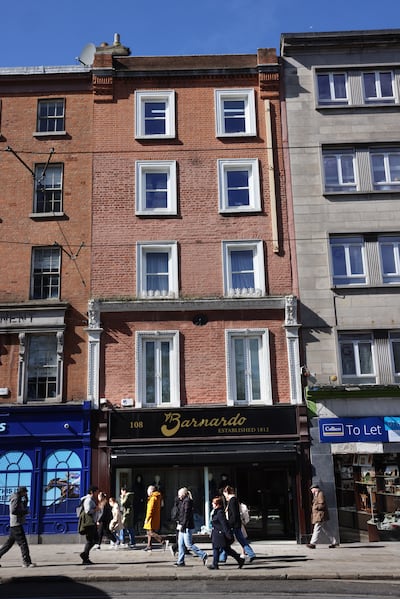
Number 109: Vacant on ground floor, the property was bought for €3 million by a company in Luxembourg called Grafton Capital Sarl, which was given an interest-free loan by its shareholder, a company called Gold Stallion Investments, of Hong Kong. The identity of the ultimate beneficial owner, or owners, is not known. In 2023 a successful planning application was submitted by Kam Wa Luk of Grafton Capital for the conversion of the first to fourth floors from offices to four residential units, including kitchen, dining and living areas overlooking Grafton Street. The Galligan beauty college currently operates from these floors. The five-storey building was constructed between 1949 and 1952.
Number 110: Another vacant property, the owner is Irish Life. Built in 1880 for auctioneer James H North, the construction of the high-Victorian commercial building caused the collapse of 111, resulting in a lawsuit against North and the contractor, Meade & Son.
Number 111: Souvenir shop Seasons of Ireland operates out of this property, owned by the Clarendon Group, a property investment group founded in the mid-1990s by Irish businessmen Paddy McKillen and Tony Leonard. The group’s Irish portfolio includes 34 College Green and the Powerscourt Centre.
Numbers 112-113: This property is vacant and owned by Irish Life. Number 112 was built in 1905 for Pigott & Co, the instrument and sheet music shop. It was in business in Dublin for 200 years when it closed, as McCullough Pigott, in 2023 on its premises on South William Street. The Grafton Street shop was destroyed by fire in 1967.
Number 114: Home to Icicle, the Chinese fashion chain, the building is owned by the retail group, which was founded in 1997 by husband-and-wife design graduates Shouzeng Ye and Xiaoma Tao. Icicle has more than 200 shops in China, two flagship outlets in Paris, shops in Japan, and owns the French couture fashion house Carven. In 2020 it set up Irish company, ICCF Investment Co, which paid €9 million for the Grafton Street building, accounts show. An Irish holding company, Guoshi Tao Ltd, was also set up in 2020 and is the owner of the group’s business in China, Japan and Europe. The 2022 accounts say the group had revenue that year of €267 million. Turnover fell in China due to the “lockdown and restrictions in several megacities” but increased in France and Japan. It had 29 subsidiaries that year, mostly in China. The accounts say the group is owned by Tao, with an address in China. A substantial building, number 114 was built in 1904 for Northern Bank and is described by the NIAH as dominating this section of Grafton Street.
Number 115: Aran Sweater Market is the tenant in this building, which has been owned since 2022 by Christopher and Niall Power Smith, with addresses in Sandymount and Ballsbridge, Dublin respectively. Niall Power Smith is an entrepreneur with interests in exploration, property and investment. Christopher Power Smith is a property developer. Built around the same time as the bank building at 114, number 115 was designed to be the bank manager’s home, with the buildings complementing each other in terms of design.
Number 116: Lush cosmetics trades out of this building, which is owned by Johnny Ronan’s RGRE Grafton group (part of his wider property empire), currently in receivership. The building above the ground floor has been converted into apartments. A duplex penthouse apartment, which has two terraces and a lift to the ground floor, is on the market with an asking price of €1.95 million. Lush is reportedly paying an annual rent of €285,000 on a lease that runs to September 2023. Built in 1906 for the bookseller Edward Ponsonby, the NIAH says number 116 has a narrow frontage indicative of its former Georgian domestic plot size but “the facade is characteristic of early twentieth-century exuberance”.
Number 117: Butler’s Chocolate Café has an outlet in this building, which is owned by Ferneley Ltd. It is also the owner of number 118 and other Dublin properties with a total value of €16 million. Ferneley is owned by members of the McConn family, who own the Dualway coach and tour group, based in Kill, Co Kildare. The two properties on Grafton Street were bought in 2014 for a reported €3.6 million.Built around 1810, number 117 was likely to be a house that was later modified for commercial use.
Number 118: Tipperary Gift Shop, another shop aimed at tourists visiting Dublin and Trinity College across the road, is the tenant here in this second Grafton Street property owned by the McConn family. In 2019 planning permission was granted to change the upper floors of numbers 117 and 118 from office to residential use and the creation of four apartments. Kapp and Peterson tobacco pipes and accessories business operated from this location for many years.
Number 119: James Fox cigars is located at the last building on the bottom of Grafton Street with the Irish whiskey museum on the upper floors. The corner building is owned by JJ Fox Ltd, a tobacconist that can trace its Dublin roots back to 1881. JJ Fox Ltd, incorporated in 1939, is owned by 17 individuals, with the largest shareholding being held by Elizabeth Fox (74) with an address in Dublin. The building, which also fronts on to College Green, was built between 1879 and 1881 for the Commercial Union Assurance Company. “The Gothic-influenced style was a significant, and at the time of its construction controversial, decision,” says the NIAH. “Today, at a distance from the stylistic battles of the 19th century, it can be seen to contribute to the diversity of the streetscape and to the rich architectural character of the Grafton Street Conservation Area.”
- Listen to our Inside Politics Podcast for the latest analysis and chat
- Sign up for push alerts and have the best news, analysis and comment delivered directly to your phone
- Find The Irish Times on WhatsApp and stay up to date










